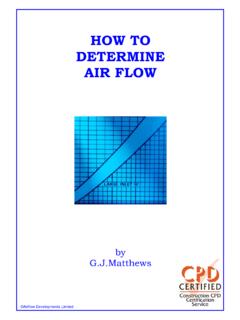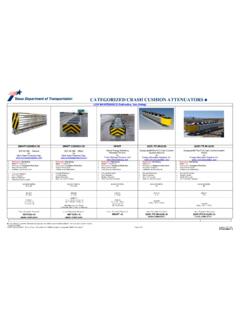Transcription of Combustion Analysis Basics - TSI.com
1 An Overview of Measurements,Methods and CalculationsUsed in Combustion AnalysisCombustion AnalysisCombustionAnalysis Basics Combustion Analysis Basics An Overview of Measurements, Methods and Calculations Used in Combustion Analysis Copyright 2004 by TSI Incorporated Combustion Analysis Basics i Contents Introduction .. 1 1 Combustion Analysis .. 2 Why Perform Combustion Analysis ?.. 3 Improve Fuel Efficiency .. 3 Reduce Emissions .. 4 Improve 4 What s Measured? .. 5 Oxygen, Carbon Monoxide and Carbon Dioxide .. 5 Temperature and Draft .. 7 Nitrogen Oxides (NOx) .. 8 Sulfur Dioxide (SO2).. 8 Hydrocarbons (HCs)/Volatile Organic Compounds (VOCs) .. 8 8 Measurement Tools .. 9 Manual Gas Portable Electronic 9 Continuous Emission Monitors ..9 Using The 10 Excess Air .. 10 Calculating the Carbon Dioxide 11 Determining Combustion 12 The O2 Reference.
2 13 Emission Conversions .. 13 Making 14 Taking Gas Samples .. 14 Making Temperature and Draft 14 Soot 15 Sample Boiler Tune-Up 16 Tune-up Procedure Using an Electronic Combustion 16 Combustion Analysis Basics ii TSI Incorporated Appendices .. 18 Appendix A. Energy 18 Appendix B. Fuel Specifications ..19 Appendix C. 20 Appendix D. 25 Bibliography .. 27 Combustion Analysis Basics Combustion Analysis Basics 1 Introduction Combustion Combustion occurs when fossil fuels, such as natural gas, fuel oil, coal or gasoline, react with oxygen in the air to produce heat. The heat from burning fossil fuels is used for industrial processes, environ-mental heating or to expand gases in a cylinder and push a piston. Boilers, furnaces and engines are important users of fossil fuels. Fossil fuels are hydrocarbons, meaning they are composed primarily of carbon and hydrogen.
3 When fossil fuels are burned, carbon dioxide (CO2) and water (H2O) are the principle chemical products, formed from the reactants carbon and hydrogen in the fuel and oxygen (O2) in the air. The simplest example of hydrocarbon fuel Combustion is the reaction of methane (CH4), the largest component of natural gas, with O2 in the air. When this reaction is balanced, or stoichiometric, each molecule of methane reacts with two molecules of O2 producing one molecule of CO2 and two mole-cules of H2O. When this occurs, energy is released as heat. CH4 + 2O2 => CO2 + 2H2O Reactants => Products + Heat In actual Combustion processes, other products are often formed. A typical example of an actual Combustion process is shown in Figure 1. Fuel has reacted with air to produce the products shown on the right. FUELAIR HEATCO2 H20 CONO NO2 SO2 Emission Gases(sometimes)O2 N2C H2S N2 Somefuels Mixing TurbulenceTemperature Contact Time Figure 1.
4 Combustion Diagram The combining of oxygen in the air and carbon in the fuel to form carbon dioxide and generate heat is a complex process, requiring the right mixing turbulence, sufficient activation temperature and enough time for the reactants to come into contact and combine. Unless Combustion is properly controlled, high concentrations of undesirable products can form. Carbon monoxide (CO) and soot, for example, result from poor fuel and air mixing or too little air. Other undesirable products, such as nitrogen oxides (NO, NO2), form in excessive amounts when the burner flame temperature is too high. If a fuel contains Combustion Analysis Basics 2 TSI Incorporated sulfur, sulfur dioxide (SO2) gas is formed. For solid fuels such as coal and wood, ash forms from in-combustible materials in the fuel. Combustion Analysis Combustion Analysis is part of a process intended to improve fuel economy, reduce undesirable exhaust emissions and improve the safety of fuel burning equipment.
5 Combustion Analysis begins with the measurement of flue gas concentrations and gas temperature, and may include the measurement of draft pressure and soot level. To measure gas concentration, a probe is inserted into the exhaust flue and a gas sample drawn out. Ex-haust gas temperature is measured using a thermocouple positioned to measure the highest exhaust gas temperature. Soot is measured from a gas sample drawn off the exhaust flue. Draft is the differential pressure between the inside and outside of the exhaust flue. Once these measurements are made, the data is interpreted using calculated Combustion parameters such as Combustion efficiency and excess air. A more in depth Analysis will examine the concentration of the undesirable products described earlier. Combustion Analysis Basics Combustion Analysis Basics 3 Why Perform Combustion Analysis ?
6 Improve Fuel Efficiency The largest sources of boiler heat losses are shown Figure 2. Heat energy leaving the system exhaust flue (or stack) is often the largest single source of lost fuel energy and is made up of the Dry Gas loss and Latent Heat Loss. Although some flue loss is unavoidable, an equipment tune-up using Combustion Analysis data can often significantly reduce this source of heat loss and save fuel costs by improving fuel efficiency. Table 1 gives examples of yearly cost savings that can be realized by improving equip-ment efficiency by five percent. Figure 2. Boiler Heat Losses Fuel Cost Boiler HP $ $ $ $ 100 $3,635 $4,847 $7,271 $9,694 200 $7,271 $9,694 $14,541 $19,389 300 $10,906 $14,541 $21,812 $29,083 500 $18,177 $24,236 $36,354 $48,471 800 $29,083 $38,777 $58,166 $77,554 Table 1.
7 Possible savings per year with a 5% improvement in boiler efficiency (based on 3000 hours per year of operation). Combustion Analysis Basics 4 TSI Incorporated Reduce Emissions Carbon monoxide, sulfur dioxide, nitrogen oxides and particles are undesirable emissions associated with burning fossil fuels. These compounds are toxic, contribute to acid rain and smog and can ulti-mately cause respiratory problems. Federal and state laws govern the permissible emission rates for these pollutants under the guidance of the Clean Air Act and oversight of the federal Environmental Protection Agency (EPA). State and local environmental agencies also exert authority in regulating the emissions of these pollutants. Combustion Analysis is performed to monitor toxic and acid rain forming emissions in order to meet these federal, state and local regulations.
8 For specific information on emissions as they relate to a particular region, contact the local regulatory agency. For general information about regulations, refer to Appendix D, Emissions. Improve Safety Good equipment maintenance practice, which includes Combustion Analysis , enables the boiler techni-cian to fully verify and maintain the equipment operating specifications for safe and efficient operation. Many boiler manufacturers suggest that flue gas Analysis be performed at least monthly. Boiler adjust-ments that affect Combustion will tend to drift with time. Wind conditions and seasonal changes in tem-perature and barometric pressure can cause the excess air in a system to fluctuate several percent. A reduction in excess air can cause, in turn, a rapid increase of highly toxic carbon monoxide and explo-sive gases, resulting in rapid deterioration in system safety and efficiency.
9 Low draft pressures in the flue can further result in these Combustion gases building up in the Combustion chamber or being vented indoors. Excessive draft pressures in the flue also can cause turbulence in the system. This can prevent complete Combustion and pull explosive gases into the flue or cause flame impingement and damage in the Combustion chamber and to the heat exchanger material. Combustion Analysis Basics Combustion Analysis Basics 5 What s Measured? Combustion Analysis involves the measurement of gas concentrations, temperatures and pressure for boiler tune-ups, emissions checks and safety improvements. Parameters that are commonly examined include: Oxygen (O2) Carbon Monoxide (CO) Carbon Dioxide (CO2) Exhaust gas temperature Supplied Combustion air temperature Draft Nitric Oxide (NO) Nitrogen Dioxide (NO2) Sulfur Dioxide (SO2) Oxygen, Carbon Monoxide and Carbon Dioxide As described earlier, simple Combustion involves the reaction of oxygen in the air with carbon and hy-drogen in the fuel, to form carbon dioxide and water and produce heat.
10 Under ideal conditions, the only gases in the exhaust flue are CO2, water vapor and nitrogen from the Combustion air. When O2 appears in the flue exhaust, it usually means that more air ( percent of which is O2) was supplied than was needed for complete Combustion to occur. Some O2 is left over. In other words, the measurement of O2 gas in the flue indicates that extra Combustion air, or Excess Air, was supplied to the Combustion reaction. This is demonstrated in Figure 3 where the bar on the right represents the exhaust gas composition. Figure 3. Excess Air Supplied When too little air is supplied to the burner, there is not enough oxygen to completely form CO2 with all the carbon in the fuel. Instead, some oxygen combines with carbon to form carbon monoxide (CO). CO is a highly toxic gas associated with incomplete Combustion and efforts must be made to minimize its formation.












